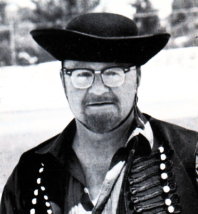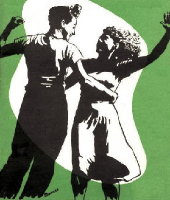
|
Folk Dance Federation of California, South, Inc.
Start Your Own |

|
CLICK AN IMAGE TO ENLARGE
 Do you live too far from the nearest Folk or Square Dance Group? Do you feel left out in the group you now attend? Are your friends afraid to come because it's too advanced a group?
Do you live too far from the nearest Folk or Square Dance Group? Do you feel left out in the group you now attend? Are your friends afraid to come because it's too advanced a group?
Okay, then — start your own group! It is easier than you think, and if it's handled properly, you and your friends can build a group to suit yourselves. Moreover, as the club grows, you'll make many swell new friends.
You only need a few simple things to organize your new club.
One: You must have a loud voice, and be unafraid to use it. I have seen people who could roar like Jupiter at a football game, yet couldn't make their voices loud enough to command attention when teaching a dance. Remember, it is not necessary to scream or yell, but you should fill up your lungs, and make your voice carry 'way across the room.
Two: You must know at least a few dances very well. I taught my first dance — "Cotton-eyed Joe" — when it was the only dance I knew thoroughly. The trick here is not merely to know it well, but to practice teaching the dance beforehand. Even if it is only before a mirror, practice explaining aloud the steps of the dance you will teach. At first you will be surprised at how much thought is needed to put the steps into words. Just a little practice, however, and you will find teaching no effort at all.
Three: You must have a place to dance. You will find most civic organizations very cooperative, and either your church, or school, or even your local playground can probably supply a place to dance — either free of charge, or for a very nominal fee.
Four: You should have a phonograph and some Folk Dance records. If you buy Square Dance records, get the kind without the calls on the record. This will not only encourage you to learn how to call, but will enable you to vary the dances, each time you use the records.
Now in organizing your group, it may help you to ask yourself these questions: Will I be the only teacher? (or caller?) Should I be paid? Should it be a closed group? The answer to all the above questions should be an emphatic NO! Don't try to carry the whole load on your own shoulders. On the contrary, you should encourage people to become leaders, at every opportunity. When they say, they don't know a thing about it, make them membership chairmen, refreshment chairmen, treasurer, a welcoming committee, anything — in fact, that gives them some sort of responsibility. When you have a leaders' meeting, do your practice teaching on them, and make them practice on you. The more you get people to come in and carry their share, just that much more cooperation and participation will you get from your members. When your members start saying "our group" instead of "your group," your club will really be on its way!
While encouraging leadership in others, you should not accept any pay for your own work, even though you do most of it. If you handle the group as suggested, you will soon have so much help, and so many active leaders, that no one will be justified in receiving a fee. Anyway, you will find it hard enough to find money enough, for refreshments and a record collection, to say nothing of building up a fund to buy a P.A. System and phonograph combination!
Your group should not be a closed group. In spite of the fact that after a majority of the group have become advanced dancers, and do not like to be slowed down by the beginners, it is never a good policy to close the membership. Some members will drop out for any number of reasons: they may move away, they may start working nights, they may no longer be able to afford a baby-sitter! New blood is always needed, and encouragement for beginners should be one of the stated policies of the club. Social groups are seldom static for very long. If they do not progress, and expand, they stagnate.
As all Square Dancers and Folk Dancers know, there is nothing so sociable and fun-producing as these weekly dances. But not until you have organized your own group will you get all the benefits that you can out of this wonderful form of recreation. Not only will you have the satisfaction of having introduced Folk and Square Dancing to a few more people, but you will derive personal benefits in the form of more poise and self-confidence before large groups of people.
That's the way I started — and believe me, it works!
From Everybody Dance, Vol. 1, No. 1, January 1950. This first and only issue of the magazine was published by Frank Pokorak and edited by Rudy Dannes, later to become co-owner of The Intersection, premier folk dance cafe in Los Angeles. Dave Slater, long-time folk dance teacher and the contributing editor for the issue, was a driving force, strong supporter, and president the Folk Dance Federation of California, South, Inc. While Dave had not "toured the circuit" as a master teacher, he was definitely a teaching master.
After reading this once again in November, 2002, Dave had this to say: "Considering how long ago it was, and how young I was, I don't think it was too bad. Of course, times have changed and places to dance are much harder to acquire, and the folk dance movement has been chopped up into so many small segments, it is really difficult to actually form an international folk dance club. And, of course, in those days I was so idealistic that I didn't think anyone needed to be paid to spread the gospel of folk dancing."